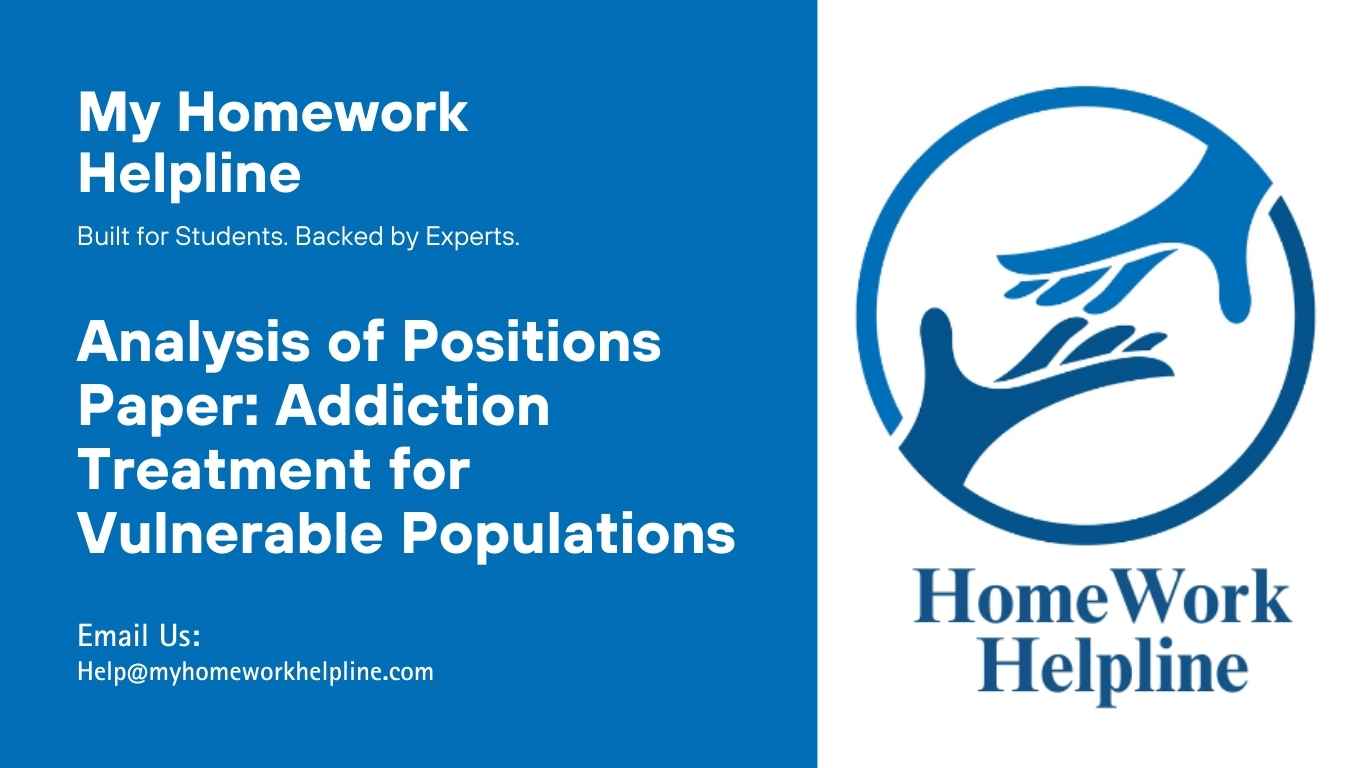Analysis of Positions Paper on Addiction Treatment and Barriers for Vulnerable Women
Healthy women help build society, yet, the group remains highly vulnerable, with millions dying from preventable causes each year globally. The vulnerability results from significant social, economic, and cultural barriers that tend to predispose them to poor health outcomes compared to men in society (Jemberie et al.., 2020). Research continues to show the significant impact of disparity in health outcomes among women, placing them at a disadvantage in society. Abuse (2020) revealed that the number of women using illicit drugs increased by 15.4% in 2020 to 19.5 million in the US. Men are usually more likely to participate in drug and substance abuse; however, women are increasingly abusing drugs. Addiction to alcohol and other drugs results in short-term and long-term issues ranging from social, physical, and psychological outcomes. Women and men are at an equal risk of experiencing adverse health issues relating to substances and alcohol abuse; however, women have unique psychological attributes that tend to predispose them to massive inequality in health and well-being.
Working on an analysis of positions paper or struggling with healthcare assignments? Our experts at Nursing Homework Helpline provide high-quality academic writing, research support, and essay assistance. From nursing homework to position papers on vulnerable populations, we deliver well-researched, plagiarism-free work that helps you achieve top grades. Get reliable guidance today and succeed in your studies with confidence!
Alcohol and substance abuse interventions are essentially designed for men. Modern research aims to develop women-friendly interventions by studying how alcohol and substance abuse impacts them. The reason is that women respond to substance and alcohol abuse differently as they may experience more relapses and cravings; are more likely to experience blood and heart disorders; and are more likely to suffer addiction when experiencing parenting and childbearing challenges (Jemberie et al.., 2020). Additionally, addiction in women is usually associated with HIV/AIDS, domestic violence, and other psychological disorders, making them particularly vulnerable compared to males. Consequently, we must diversify solutions that encourage women to deal with substance and alcohol addiction, hence effective treatment and eliminating barriers limiting treatment interventions.
Addiction Treatment and Barriers
Current treatment models approach drug abuse as a brain disorder. Meyer et al. (2019) note that drug use and addiction are behavioral and mental issues and should be addressed using multifaceted approaches. Therefore, early intervention that targets children and adults encouraging abstinence from use later in life should be encouraged. Addiction is also considered a chronic issue rather than an acute health problem based on its complex interaction between biological and environmental factors and repeated drug exposure. Protracted approaches show a positive outcome in addressing drug abuse among women, compared to short-term interventions.
Addiction is also discussed as a disease that afflicts the brain and behavior. However, the disease is treatable despite being chronic in nature. According to Pinedo et al. (2020), emerging reports on addiction focusing on attachment problems that develop in early childhood and adolescence have noted the growing need for interventions such as emotionally-focused therapy and the 12-step program in addressing the chronic addictive disorder. Addiction is currently termed as a chronic medical disease that is treatable, with prevention and treatment approaches being as effective as those of other chronic diseases.
Supporters of the brain disease model argue that drugs tend to alter certain parts of the brain. In some cases, there is a genetic predisposition hence limiting addiction as a moral issue. Individuals suffering from addiction are not accountable for drug use as ‘compulsion’ is a defining feature of addiction, whereby drug users tend to lose voluntary control over drug abuse. Stigmatizing addiction as a moral problem is scientifically incorrect and leads to a loss of tax dollars (Jemberie et al.., 2020). Research shows that stigma acts as a barrier to seeking help. For instance, research shows that women’s addiction rate is at par with that of men, but as a result of addiction stigma, most women prefer to suffer alone rather than seek help. According to Abuse (2020), women are under-represented in addiction treatment, making up a third of the people receiving treatment. Stigma, shame, and fear of social and legal repercussions, such as child protection involvement, are significant barriers to addiction treatment for women.
Consciousness is an essential topic in the brain disease model. Research shows that human beings are conscious of themselves and their environment. We are conscious that we will die; we like and dislike certain things and need to avoid other things. We are conscious of society’s expectations of us and have a future to live. Studies reveal that addiction tends to impact the life experience of drug users. For instance, alcoholics tend to perceive intoxication as improving their mood; marijuana influences individuals to believe that time is slowing down and jokes are funnier; and individuals using hallucinogens believe that they are more creative when creating art or solving problems (Abuse, 2020). Thus, intoxication alters individuals’ consciousness making them more attracted to drugs.
However, there are several critics against the brain disease model of addiction. Critics note that the model failed due to the inability to deliver promised efficacy during treatment. According to Meyer et al. (2019), the model is too limited to comprehend other pieces of evidence, such as addiction cannot be entirely based on the impacts of drugs on the brain. Evidence shows that addiction is environmentally based since numerous people only use drugs for reactionary purposeless without being addicted. Studies conducted to understand the needs of women using illicit drugs revealed that women face a myriad of particular gender-specific barriers and challenges, enhancing their vulnerability to health-related issues (Jemberie et al., 2020). The problems include but are not limited to viral infection, sexually transmitted diseases, poor reproductive and sexual health, stigmatization and endemic discrimination, physical and sexual violence, childbearing and childcare challenges, and mental health disorders. The comorbidity of addiction and other diseases adds to the difficulties of developing a practical treatment approach targeting women. Studies also revealed that women with co-occurrence of health disorders and substance abuse are likely to require more treatment time than men. A major factor that influences retention among women is depression.
Short-term versus Long-term Addiction Treatment
Understanding addictive disorders can influence treatment and prevention approaches. According to Pinedo et al. (2020), the barriers to addressing addiction are revealed by the continued pervasive prevalence of relapse incidence. Addressing drug addiction as a chronic issue encourages using long-term and preventative behavioral therapeutic approaches. Furthermore, it assists in solving addiction efficiently and wholesomely. However, the complexity of the addiction mechanism and the surrounding environmental risk factors tend to complicate treatment and prevention strategies by targeting adults rather than the young generation (Kozhimannil et al., 2019). The adoption of a new approach for addiction encompassing chronic, mental, and behavioral aspects will offer a basis for shifting the intervention effectiveness of single-prolonged approaches.
Short-term addiction intervention is suitable based on its cost-effectiveness. The approach’s effectiveness complements the provision of scarce resources as it does not require massive resources. Researchers argue that short-term interventions arrest the immediate issues in instances where addicts have adverse and numerous risk factors. Therefore, identifying specific and overarching phenomenon that triggers addictive behavior has assisted in reversing drug addiction habits among the adult population. Furthermore, the brain disease model of addiction advocates for pharmacological drug abuse treatment using opioid medication (Abuse, 2020). This has resulted in dependency on treatment drugs, hence not treating addiction but leading to the opioid crisis.
Critics claim that short-term treatment and prevention are insufficient in treating relapse patients. Studies show that women having drug addiction are at a higher risk of developing hepatitis B and C, and HIV/AIDs, in addition to being prone to violence and abuse (Pinedo et al., 2020). Additionally, women are victims of community stigma, which tends to impact their ability to seek treatment. Their role as child bearers and caregivers complicates their treatment due to its impact on the child and the fear of involving social services. In addition, substance abuse among women of childbearing age has significantly increased with the increase in social and economic hardships.
According to Pinedo et al. (2020), addiction prevention and treatment should consider women’s unique physiology and circumstances. A multidisciplinary and multifaceted approach that brings family counsellors, addiction therapists, and community workers together would assist in holistically addressing the issue, therefore improving health outcomes and efficacy. According to Meyer et al. (2019), multiple factors lead to addiction, making it complex; a single treatment approach may not be effective in overcoming the addiction because of the chronic nature of the disease. Treatment and prevention have to be continuous, beginning from early childhood and adolescence to adulthood. Alcohol and drug abuse can be prevented by creating awareness, educating people, and avoiding risk factors. For people suffering from addiction, especially women, a multifaceted approach can help address all the causes and symptoms (Kozhimannil et al., 2019). Thus, women suffering from psychological problems and drug abuse can access psychological treatment while also receiving drug abuse treatment. Additionally, medical care, individualization, social support, and behavioral therapy are vital in completing the treatment of drug abuse among women. Medical care can allow the treatment of underlying physical conditions, while drugs can be used for recovery. Social support from family and friends significantly influences addiction recovery among women. Behavioral therapy is vital in addressing how patients learn to be aware and take responsibility for unwanted behavior.
Conclusion
Addiction is not a simple condition that can be addressed using a single approach. A single factor does not cause the addition, and no quick fix or single treatment can address the problem. Drug addiction treatment is highly impacted by relapses, leading to short-term interventions having limited impact on prevention and treatment. Multifaceted approaches are gaining more popularity in addiction treatment since other treatment models face numerous limitations. Previous intervention methods did not offer approaches to address multiple issues affecting women as they experience diverse and unique addiction-related complications and health issues. The current prevention strategies employed are gender-blind and thus hardly address the needs and challenges of the vulnerable group. Numerous position papers acknowledge the complexity of treating addiction and support adopting a multipronged approach, even though the practice is counterproductive. In addition to economic and social disempowerment among women, comorbid addiction indicates that they are a vulnerable segment of the population, especially in relation to addiction and relapsing when other underlying issues are not concurrently addressed. Thus, to enhance care efficacy among women in relation to addictive disorders, a holistic and multidisciplinary approach has to be developed targeting women specifically.
References
Abuse, S. (2020). Key substance use and mental health indicators in the United States: results from the 2019 National Survey on Drug Use and Health.
Jemberie, W. B., Stewart Williams, J., Eriksson, M., Grönlund, A. S., Ng, N., Blom Nilsson, M., … & Lundgren, L. M. (2020). Substance use disorders and COVID-19: multi-faceted problems which require multi-pronged solutions. Frontiers in psychiatry, 11, 714.
Kozhimannil, K. B., Dowd, W. N., Ali, M. M., Novak, P., & Chen, J. (2019). Substance use disorder treatment admissions and state-level prenatal substance use policies: Evidence from a national treatment database. Addictive behaviors, 90, 272-277.
Meyer, J. P., Isaacs, K., El-Shahawy, O., Burlew, A. K., & Wechsberg, W. (2019). Research on women with substance use disorders: Reviewing progress and developing a research and implementation roadmap. Drug and Alcohol Dependence, 197, 158-163.
Pinedo, M., Zemore, S., Beltrán-Girón, J., Gilbert, P., & Castro, Y. (2020). Women’s barriers to specialty substance abuse treatment: A qualitative exploration of racial/ethnic differences. Journal of immigrant and minority health, 22, 653-660.

